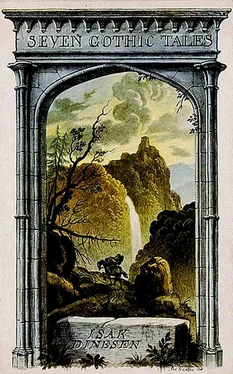Isak Dinesen - Seven Gothic Tales
Здесь есть возможность читать онлайн «Isak Dinesen - Seven Gothic Tales» — ознакомительный отрывок электронной книги совершенно бесплатно, а после прочтения отрывка купить полную версию. В некоторых случаях можно слушать аудио, скачать через торрент в формате fb2 и присутствует краткое содержание. Жанр: unrecognised, на английском языке. Описание произведения, (предисловие) а так же отзывы посетителей доступны на портале библиотеки ЛибКат.
- Название:Seven Gothic Tales
- Автор:
- Жанр:
- Год:неизвестен
- ISBN:нет данных
- Рейтинг книги:5 / 5. Голосов: 1
-
Избранное:Добавить в избранное
- Отзывы:
-
Ваша оценка:
- 100
- 1
- 2
- 3
- 4
- 5
Seven Gothic Tales: краткое содержание, описание и аннотация
Предлагаем к чтению аннотацию, описание, краткое содержание или предисловие (зависит от того, что написал сам автор книги «Seven Gothic Tales»). Если вы не нашли необходимую информацию о книге — напишите в комментариях, мы постараемся отыскать её.
The stories in this collection are:
Deluge at Norderney
The Old Chevalier
The Monkey
The Roads round Pisa
The Supper at Elsinore
The Dreamers
The Poet
Seven Gothic Tales — читать онлайн ознакомительный отрывок
Ниже представлен текст книги, разбитый по страницам. Система сохранения места последней прочитанной страницы, позволяет с удобством читать онлайн бесплатно книгу «Seven Gothic Tales», без необходимости каждый раз заново искать на чём Вы остановились. Поставьте закладку, и сможете в любой момент перейти на страницу, на которой закончили чтение.
Интервал:
Закладка:
This was because in the midst of their misery the terror-stricken people got support from one already half-mythical figure, and felt at their side the presence of a guardian angel. Many years after, in the minds of the peasants, it seemed that his company in their dark despair had shed a great white light over the black waves.
The Cardinal Hamilcar von Sehestedt had, during the summer, been living in a small fisherman’s house at some distance from the bath, to collect his writings of many years in a book upon the Holy Ghost. With Joachim de Flora, who was born in 1202, the Cardinal held that while the book of the Father is given in the Old Testament, and that of the Son, in the New, the testament of the Third Person of the Trinity still remained to be written. This he had made the task of his life. He had grown up in the Westerlands, and had preserved, during a long life of travels and spiritual work, his love for the coast scenery and the sea. In his leisure hours he would go, after the example of St. Peter himself, a long way out on the sea with the fishermen in their boats, to watch their work. He had with him in his cottage only a sort of valet or secretary, a man by the name of Kasparson. This man was a former actor and adventurer, a brilliant fellow in his way, who spoke many languages and had been given to all sorts of studies. He was devoted to the Cardinal, but he seemed a curious Sancho Panza for the noble knight of the church.
The name of Hamilcar von Sehestedt was at that time famous all over Europe. He had been made a Cardinal three years before, when he was only seventy. He was a strange flower upon the old solid wood of the Sehestedt family tree. An old noble race of the province had lived for many hundred years for nothing but wars and their land, to produce him. The one remarkable thing about them was that they had stuck, through many trials, to the ancient Roman Catholic faith of the land. They had no mobility of spirit to change what they had once got into their heads. The Cardinal had nine brothers and sisters, none of whom had shown any evidences of a spiritual life. It was as if some slowly gathered and quite unused store of intellectuality in the tribe had come out in this one child of it. Perhaps a woman, imported from outside, had dropped a thought into the blood of it before becoming altogether a Sehestedt, or some idea in a book had impressed itself upon a young boy before he had been taught that books and ideas mean nothing, and all this had mounted up.
The extraordinary talents of young Hamilcar had been recognized, not by his own people, but by his tutor, who had been tutor to the Crown Prince of Denmark himself. He succeeded in taking the boy off to Paris and Rome. Here this new light of genius suddenly flared up in a clear blaze, impossible to ignore. There existed a tale of how the Pope himself, after the young priest had been presented to him, had seen in a dream how this youth had been set apart by providence to bring back the great Protestant countries under the Holy See. Still, the church had tried the young man severely, distrustful of many of the ideas and powers in him, of his visionary gift, and of the most striking feature of his nature: an immense capacity for pity which embraced not only the sinful and miserable but seemed to turn even toward the high and holy of the world. Their severity did not hurt him; obedience was in his nature. To his great power of imagination he joined a deep love of law and order. Perhaps in the end these two sides of his nature came to the same thing: to him everything seemed possible, and equally likely to fall in with the beautiful and harmonious scheme of things.
The Pope himself, later, said of him: “If, after the destruction of our present world, I were to charge one human being with the construction of a new world, the only person whom I would trust with this work would be my young Hamilcar.” Whereupon, however, he quickly crossed himself two or three times.
The young Cardinal, after the church had handled him, came out a man of the world in the old sense of the word, but in a new and greater proportion. He moved with the same ease and grace amongst kings and outcasts. He had been sent to the missionary monasteries of Mexico, and had had great influence with the Indian and half-caste tribes there. One thing about him impressed the world everywhere: wherever he went, it was believed of him that he could work miracles. At the time of his stay in Norderney the hardened and heavy coast people took to thinking strange things of him. After the flood it was said by many that he had been seen to walk upon the waves.
He may have felt handicapped in this feat, for he was nearly killed at the very start of events. When the fishermen from the hamlet, as the flood came on, ran to his assistance, they found his cottage already half a ruin. In the fall of it the man Kasparson had been killed. The Cardinal himself was badly wounded, and wore, all during his rescue work, a long, blood-stained bandage wound about his head.
In spite of this the old man worked all day with undaunted courage with the ruined people. The money that he had had with him he gave over to them. It was the first contribution to the funds which were afterward collected for the sufferers from all over Europe. Much greater still was the effect of his presence amongst them. He showed good knowledge of steering a boat. They did not believe that any vessel holding him could go down. On his command they rowed straight in amongst fallen buildings, and the women jumped into the boats from the house roofs, their children in their arms. From time to time he spoke to them in a strong and clear voice, quoting to them the book of Job. Once or twice, when the boat, hit by heavy floating timbers, came near to capsizing, he rose and held out his hand, and as if he had a magic power of balance, the boat steadied itself. Near a farmhouse a chained dog, on the top of its kennel, over which the sea was washing, pulled at its chain and howled, and seemed to have gone mad with fear. As one of the men tried to take hold of it, it bit him. The old Cardinal, turning the boat a little, spoke to the dog and loosened its chain. The dog sprang into the boat. Whining, it squeezed itself against the old man’s legs, and would not leave him.
Many peasant households had been saved before anybody thought of the bath. This was strange, as the rich and gay life out there had played a big part in the minds of the population. But in the hour of danger old ties of blood and life were stronger than the new fascination. At the baths they would have light boats for pleasure trips, but few people who knew how to maneuver them. It was not till noon that the heavier boats were sent out, advancing fathom-high over the promenade.
The place where the boats unloaded, on their return landward, was a windmill which, built on a low slope and a half-circular bastion of big stones, gave them access to lay to. From the other side of it you could somehow move on by road. Here, at a distance, horses and carts had been brought up. The mill itself made a good landmark, her tall wings standing up, hard and grim, a tumbledown big black cross against a tawny sky. A crowd of people was collected here waiting for the boats. As they came in from the baths for the first time there were no tears of welcome and reunion, for these people they carried, luxuriously dressed even in their panic, with heavy caskets on their knees, were strangers. The last boat brought news that there were still, out at Norderney, four or five persons for whom no place had been found in the boat.
The tired boatmen looked at one another. They knew the tide and high sea out there, and they thought: We will not go. Cardinal Hamilcar was standing in a group of women and children, with his back to the men, but as if he could read their hardening faces and hearts he became silent. He turned and looked at the newly arrived party. Even he seemed to tarry. Below the white bandages his eyes rested on them with a singular, a mysterious expression. He had not eaten all day; now he asked for something to drink, and they brought him a jug of the spirits of the province. Turning once more toward the water he said quietly, Eh bien. Allons, allons. The words were strange to the peasants, for they were terms used by the coachmen of the nobility, trained abroad, for their teams of four horses. As he walked down to the boat, and the people from the bath dispersed before him, some of the ladies suddenly and wildly clapped their hands. They meant no harm. Knowing heroism only from the stage, they gave it the stage’s applause. But the old man whom they applauded stopped under it for a moment. He bowed his head a little, with an exquisite irony, in the manner of a hero upon the stage. His limbs were so stiff that he had to be supported and lifted into the boat.
Читать дальшеИнтервал:
Закладка:
Похожие книги на «Seven Gothic Tales»
Представляем Вашему вниманию похожие книги на «Seven Gothic Tales» списком для выбора. Мы отобрали схожую по названию и смыслу литературу в надежде предоставить читателям больше вариантов отыскать новые, интересные, ещё непрочитанные произведения.
Обсуждение, отзывы о книге «Seven Gothic Tales» и просто собственные мнения читателей. Оставьте ваши комментарии, напишите, что Вы думаете о произведении, его смысле или главных героях. Укажите что конкретно понравилось, а что нет, и почему Вы так считаете.












